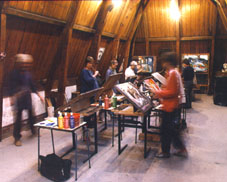Review Educare
| Inner Images coming to life: The timeless hour in elementary schools. English translation of an article published in the Dutch magazine ‘Educare’, year 19, nr. 1, 2001.Author: Margaret Bloemhof |
||
|---|---|---|
It is a bit of a search to find Michiel Dhont’s workplace ‘Werkplaats Molenpad’.
 It turns out to be situated in a large old building in a nondescript back-street off Amsterdam’s famous hot spot, the Leidseplein. A maze of staircases and corridors eventually leads the visitor to a spacious loft under the beams of a roof-construction in which the shipbuilding-techniques of a past era were used; a vessel turned upside down. |
During many years of working with students of all ages Michiel Dhont has developed a series of exercises aimed at developing ‘unity of head, heart and hands.’ The remarkable images that are the fruit of his approach, cannot but make one curious as to what it is that brought them about. Michiel, artist and musician, works with silence and movement, has students alternate between the dominant and non-dominant hand when drawing, use both hands at the same time, insist they don’t only knead clay but also feel and sense it, has objects change hands many times while being ‘worked on.’ This starts a process that will integrate the working of both hemispheres of the brain, release tension, lead to awareness of one’s creativity, enhance body-awareness, balance ‘felt senses’ and mental-cognitive powers. Michiel’s students are adults as well as primary school children. Catering to the latter group, the beautifully styled book-cum-video ‘The timeless Hour’ shows Michiel’s approach in 22 exercises that can be followed by schoolteachers wanting to link art-work and inner development. |
Applying these exercises opens a way for children to get to know their ‘inner images’, allowing an interweaving of perception and experience.The exercises stimulate intuition and help children to become ‘complete’ human beings. Today we will experience the working of it all, hands-on. So it’s to the virgin sheet of paper we go, that is, after a short self-introduction, a movement-exercise and, last but not least, the putting away of our watches. This is to be a day outside the confines of time! We seat ourselves in a semi-circle in front of the easel. A kind of dance begins, in which one after another, sometimes two at a time, piece of charcoal in each hand, we participants draw our traces, witnesses of an inner movement that wasn’t known until this very moment, leaving marks of a highly individual ‘us-ness.’ We produce a drawing for all of us, yet possessed by no-one. In so doing we run into our conditionings regarding ‘me and mine,’ (in)tolerance of what others are adding, the taking and passing on of our turns. It is fascinating to see everyone’s responses, and to find how as a group almost instantly we form some kind of ‘body,’ a whole that is more than the sum of its parts. |
The ‘old hands’ tell us how different is each drawing made in this way, showing each group’s ‘soul’ to be unique. Soon all awareness of time and hour disappears, replaced by crystal-clear attention and an open space in which the unexpected can take place. After lunch we are each given a piece of clay that we roll into a ball and with which we connect in various ways: we hold it in our hands and feel it with eyes closed, we throw it in the air and catch it in different ways; in pairs and with closed eyes we knead it into a form that we hand to our partner at the signal ‘exchange.’ Silently we ‘feel through’ the object we receive and continue working on it. This exchanging is done many times; the series is closed by bringing the object to our forehead and observing it; from a distance, from real close by. The object and the process of creating it are re-felt and incorporated. There is a short verbal exchange on what took place. Next a drawing in crayon is made, a distillation of the process of working with the clay. Next comes painting, gouache on wet paper. We moisten the paper with our hands and ‘glue’ it onto one of the many boards by the wall, silent witnesses of countless other paintings that have originated here, in the empty squares in the middle, bordered by left-over traces of color, ineradicable, growing with each new painting that is being made. We cover the paper with a ground color, again using our hands. Then we may continue with brushes, but I have acquired a taste for this and using my hands I fill the paper with dots and lines in one color after the other. We close the day looking at all the paintings, sensing each one of them; a short tour through a New Age where the artist in each one of us is coming into his own. This is marvelous, this really feels great. Then the clay is returned to its original form and stored away, well moistened. Containers, boards, brushes and palettes get meticulously cleaned. All is ready for the next round.